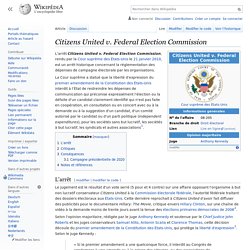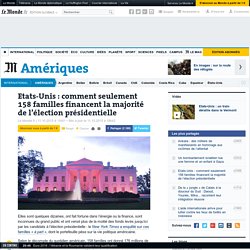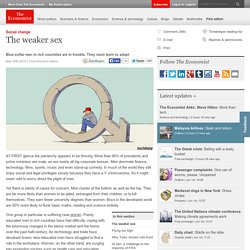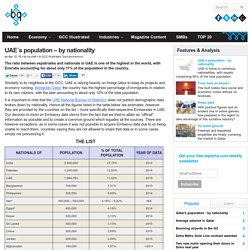

The Families Funding the 2016 Presidential Election. By NICHOLAS CONFESSORE, SARAH COHEN and KAREN YOURISH They are overwhelmingly white, rich, older and male, in a nation that is being remade by the young, by women, and by black and brown voters. Across a sprawling country, they reside in an archipelago of wealth, exclusive neighborhoods dotting a handful of cities and towns. Citizens United v. Federal Election Commission. L'arrêt Citizens United v.

Federal Election Commission, rendu par la Cour suprême des États-Unis le 21 janvier 2010, est un arrêt historique concernant la réglementation des dépenses de campagne électorale par les organisations. La Cour suprême a statué que la liberté d'expression du premier amendement de la Constitution des États-Unis interdit à l’État de restreindre les dépenses de communication qui préconise expressément l'élection ou la défaite d'un candidat clairement identifié qui n'est pas faite en coopération, en consultation ou en concert avec ou à la demande ou à la suggestion d'un candidat, d'un comité autorisé par le candidat ou d'un parti politique (independent expenditures), pour les sociétés sans but lucratif, les sociétés à but lucratif, les syndicats et autres associations[1].
Etats-Unis : comment seulement 158 familles financent la majorité de l’élection présidentielle. Elles sont quelques dizaines, ont fait fortune dans l’énergie ou la finance, sont inconnues du grand public et ont versé plus de la moitié des fonds levés jusqu’ici par les candidats à l’élection présidentielle : le New York Times a enquêté sur ces familles « à part », dont le portefeuille pèse sur la vie politique américaine.

Selon le décompte du quotidien américain, 158 familles ont donné 176 millions de dollars, soit près de la moitié des fonds levés jusqu’ici par les candidats : une concentration inédite depuis les années 1970. Ces familles sont évidemment loin d’être représentatives du foyer américain moyen et tirent majoritairement leur fortune de la finance, du secteur de l’énergie ou du divertissement. Elles forment ce que le Times décrit comme « une classe à part, loin de la plupart des Américains tout en étant géographiquement, socialement et économiquement proches les unes des autres ». Supreme Court Backs White House on Jerusalem Passport Dispute. Photo WASHINGTON — In an important separation-of-powers decision, the Supreme Court on Monday ruled that Congress may not require the State Department to indicate in passports that Jerusalem is part of Israel.

The vote was 6 to 3, with Chief Justice John G. Roberts Jr. and Justices Antonin Scalia and Samuel A. Alito Jr. dissenting. Justice Anthony M. In dissent, Chief Justice Roberts said the majority had taken a bold step. Explicit cookie consent. AT FIRST glance the patriarchy appears to be thriving.

More than 90% of presidents and prime ministers are male, as are nearly all big corporate bosses. Men dominate finance, technology, films, sports, music and even stand-up comedy. In much of the world they still enjoy social and legal privileges simply because they have a Y chromosome. So it might seem odd to worry about the plight of men. Yet there is plenty of cause for concern.
One group in particular is suffering (see article). From nuclear families to fissile ones Those on the political left tend to focus on economics. Those on the right worry about the collapse of the family. Explicit cookie consent. FOR decades rich countries have sought to foster global development with aid.

But all too often there is little to show for their spending, now over $135 billion a year and rising. Success depends on political will in recipient countries, says Erik Solheim of the Development Assistance Committee of the OECD, a club of mostly rich countries that includes the biggest donors. And that may well be lacking. What donors will pay for may not be what recipients deem a priority. So poor countries’ governments say what they must to get cash, and often fail to keep their side of the deal. Now donors are trying a new approach: handing over aid only if outcomes improve.
At the moment, donors fearful of theft or waste usually write detailed plans for how their money is to be spent and insist that they are followed to the letter. Obama to Limit Military-Style Equipment for Police Forces.
UAE´s population - by nationality. The ratio between expatriates and nationals in UAE is one of the highest in the world, with Emiratis accounting for about only 11% of the population in the country.

Similarly to its neighbors in the GCC, UAE is relying heavily on foreign labor to keep its projects and economy running. Alongside Qatar, the country has the highest percentage of immigrants in relation to its own citizens, with the later amounting to about only 10% of the total population. It is important to note that the UAE National Bureau of Statistics does not publish demographic data broken down by nationality. Hence all the figures listed in the table below are estimates, however they are provided by the countries on the list – more specifically their respective Embassies in UAE. Our decision to insist on Embassy data stems from the fact that we tried to attain as “official” information as possible and to create a common ground which equates all the sources.